POLONNARUWA
The well-preserved ruins of Polonnaruwa, the royal medieval capital of Sri Lanka in 1073, are one of the most prominent cultural locations in the country. First a military base for invading South Indian Chola tribes until they were overthrown by King Vijayabahu in 1070, Polonnaruwa was eventually created by King Parakramabahu I into a town and became the capital of the country until the early 13th century.
The ancient town is in extremely excellent nickname and is an intriguing cultural site to visit, home to a palace's ruins, a huge dagaba, amazing sculptures, and a striking building with such uncommon architecture that historians are still unaware of today.
Some of the most remarkable ruins are the Gal Viahara carvings, which in the center of the 12th century were cut into granite stone. The whole sculpture consists of four colossal Buddha statues-a samadhi image in meditation posture; a seated Buddha image inside a cave; a standing Buddha image 23 ft tall, and a 46 ft lying Buddha image depicting the passing away. Chart-topping British rock band Duran Duran went to this tropical island paradise in 1982 to create their music video "Save a Prayer," and an ideal backdrop was created by the ancient town of Polonnaruwa. So, as Save a Prayer by Duran Duran says:' You don't have to dream all of it— just live a day.' And a day at Polonnaruwa will create living memories that will last a lifetime.
ATTRACTIONS IN POLONNARUWA
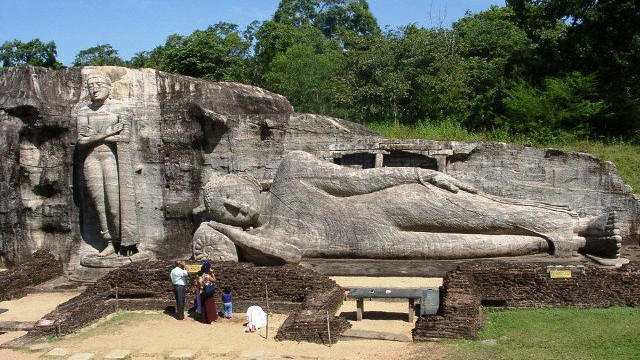
GAL VIHARA
The Gal Vihara, also known as Gal Viharaya and originally known as the Uttararama, is a Buddha’s rock temple located in the ancient town of Polonnaruwa in Sri Lanka. Parakramabahu I fashioned it in the 12th century. The temple’s main characteristic is four Buddha rock relief sculptures carved into the face of a big granite rock.
The pictures are a big sitting figure, another smaller sitting figure inside an artificial cavern, a standing figure and a reclining figure. These are regarded some of the finest examples of ancient Sinhalese sculpture and carving arts, making the Gal Vihara Polonnaruwa's most visited landmark.
Uttararama's pictures adopt a distinct style from the earlier Anuradhapura period's pictures and demonstrate some important distinctions. The standing image's identity is subject to a certain quantity of controversy between historians and archeologists, some of whom argue that it portrays the Ananda monk rather than the Buddha. Each of the pictures was sculpted in a manner that utilizes as much of the rock as possible and their heights seem to have been decided on the basis of the rock's height itself. Each statue, as stated by the remains of brick walls at the site, appears to have had its own picture house. The Uttararama was where Parakramabahu I kept a congregation of monks to purify the priesthood of Buddhism and later drew up for them a code of behavior. This code of behavior was recorded on the same rock face in an inscription containing Buddha's images.

POLONNARUWA VATADAGE
The Vatadage of Polonnaruwa is an ancient structure that dates back to Sri Lanka’s Polonnaruwa Kingdom. It is thought that during the reign of Parakramabahu I was constructed to hold the Buddha’s tooth relic or during the reign of Polonnaruwa’s Nissanka Malla to hold the Buddha’s alms bowl.
Both of these venerated relics at the moment would have provided excellent meaning and importance to the structure. It is the best preserved instance of a vatadage in the nation, located in the ancient town of Polonnaruwa, and has been characterized as the "ultimate growth" of this type of architecture. Excavation research at the Polonnaruwa Vatadage started in 1903, abandoned for several decades.
The structure has two stone platforms decorated with elaborate stone sculptures, built to protect a tiny stupa. A single door facing the north enters the reduced platform, while the second platform can be accessed through four doors facing the four cardinal points. Surrounded by a brick wall, the upper platform includes the stupa. It is surrounded by four Buddha statues, each facing one of the entrances. There were also three concentrated rows of stone columns, probably to support a wooden roof. The whole structure is adorned with sculptures of stone. Some of the sculptures at the Polonnaruwa Vatadage are regarded the finest examples of such architectural characteristics, such as its sandakada pahanas. Although it has been suggested by some archeologists that it also has a wooden roof, others dispute this hypothesis.
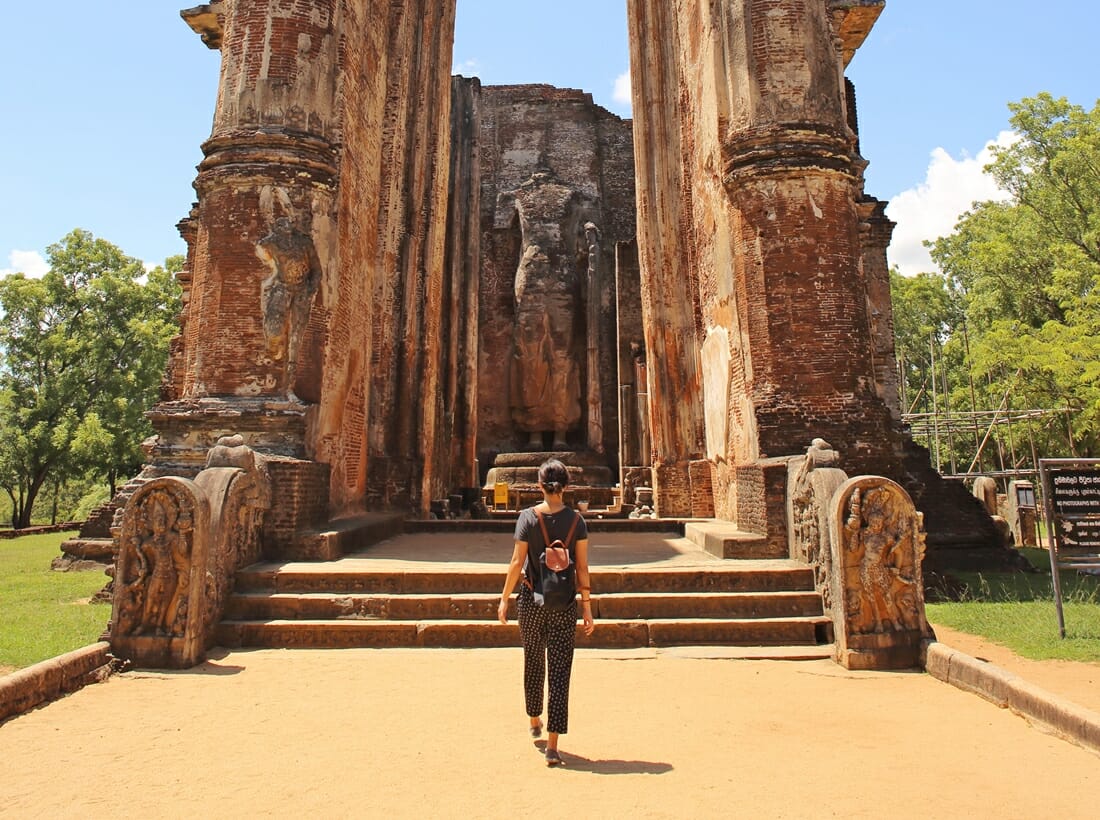
POLONNARUWA LANKATHILAKA IMAGE HOUSE
Polonnaruwa Lankathilaka Image House is a monolithic Buddha house constructed on the south side of Kiri Vehera by King Parakramabahu (1153-1186). The house is full with bricks and the exterior walls are covered with sophisticated designs and sculptures. The statue of the Buddha is also produced entirely of clay bricks and it was 41 feet high.
This statue was built with specially made flat bricks and today the part above the shoulder is demolished. There are two huge pillars made of bricks at the entrance to the Lankathilaka building. The highest is 58 feet high. These pillars are believed to have been twice as high before destruction. This building has had five stories, according to chronicles. This is also a part of the Privena Alahana.
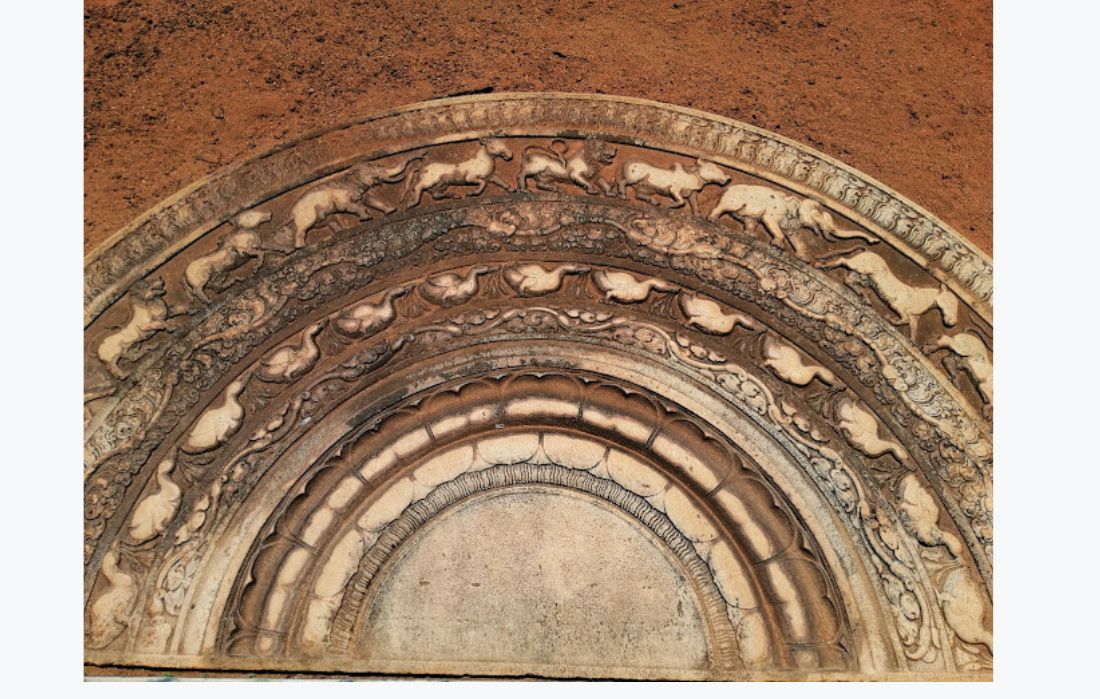
SANDAKADA PAHANA (THE MOON STONE)
Sandakada pahanas are semi-circular stone slabs, elaborately sculpted and generally discovered at the bottom of staircases and entrances. But Polonnaruwa’s ruins show distinctive departures from this ancient and beautiful Sinhalese architectural custom’s traditional characteristics.
Moonstones featured a half lotus in the center during the previous Anuradhapura period, surrounded by bands portraying swans, foliage, and four procession animals: elephants, lions, horses, and bulls. However, the single band depicting the four animals was separated with the Polonnaruwa moonstones, and each was given its own distinct band. Meanwhile, instead of putting moonstones only at entrances to Buddhist temples in the Anuradhapura tradition, they are also discovered at other buildings ' entrances in Polonnaruwa.
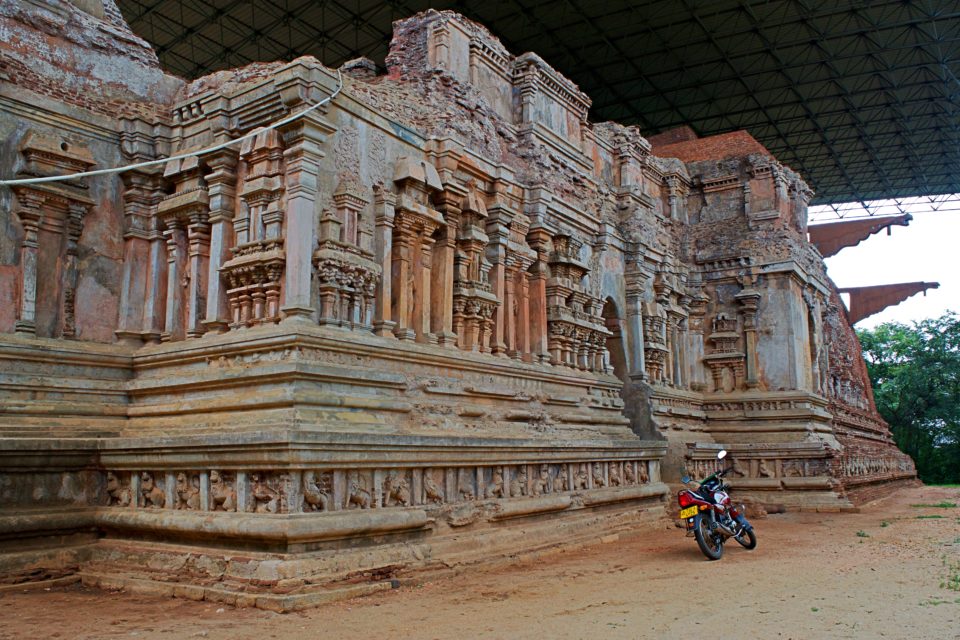
THIVANKA IMAGE HOUSE
Thivanka Pilimage image house and original wall paintings, classical art and carvings in their initial form are undoubtedly a highlight of any visit to Polonnaruwa’s ruins. Built by King Parakramabahu (1153–1186) as part of the Jethavanarama Complex, it involves an imposing Buddha sculpture curved in three locations, hence the name ‘ Thivanka.’ The sheer quantity, style and quality on display led one art
scholar to say that the dominant characteristics of the internal chambers ' walls are elegance, elaboration and magnificence. A pleasure to behold is the graceful expressions on the faces of the gods, the dramatic poses in which their bodies were cast and the delicate fingers held in equally dramatic mudras.
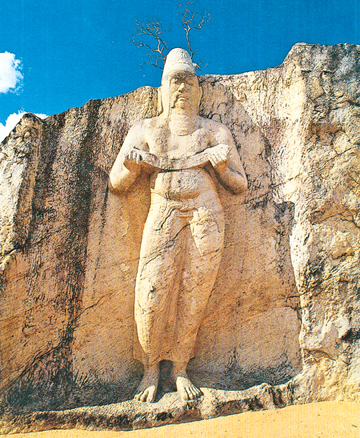
STATUE OF PARAKRAMABAHU OR PULASTYA RISHI
The magnificent statue of 11 ft 2 in (3.40 m), sculpted from a rock face just north of Polonnaruwa’s primary ruins, is a source of mystery and speculation. It is believed to portray either King Parakramabahu I himself or perhaps a famous 12th-century sage. It is definitely an impressive figure, a grave of face, holding in his two hands what might be a book.
Noted historian Mendis Rohanadeera proposed depicting a person from the Lambakanna clan, citing the fact that a hare, a symbol of Lambakanna, can be seen above his left shoulder. But others have pointed out that the statue is situated near the ancient library of Potgul Vehera and is thus likely a tribute to one of the esteemed and respected sages of Polonnaruwa.
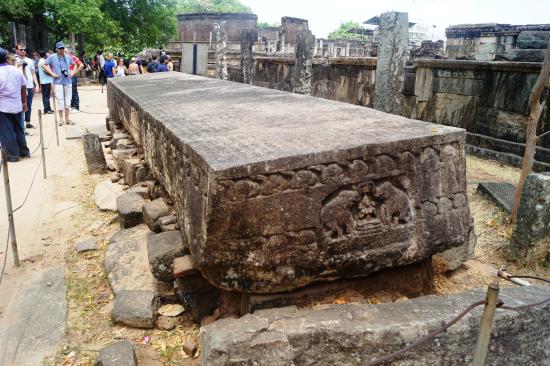
GAL-POTHA STONE BOOK
A massive slab 26 ft 10ins (8.2 m) long and 4 ft 7ins (1.4 m) broad, the Gal Potha, or Stone Book, is literally a cornerstone showing some of Polonnaruwa’s history. The text— three columns, 72 lines and 4,300 characters— is the king’s own character reference to himself, created by King Nissanka Malla, who ruled from 1187 to 1196.
. It not only lauds his accomplishments but also sets out his eligibility to occupy Sri Lanka's royal throne. As well as the text, the rock side portrays lovely sculptures of two rows of geese, plus a seated Goddess Lakshmi figure holding two flowers, with elephants pouring water over it.
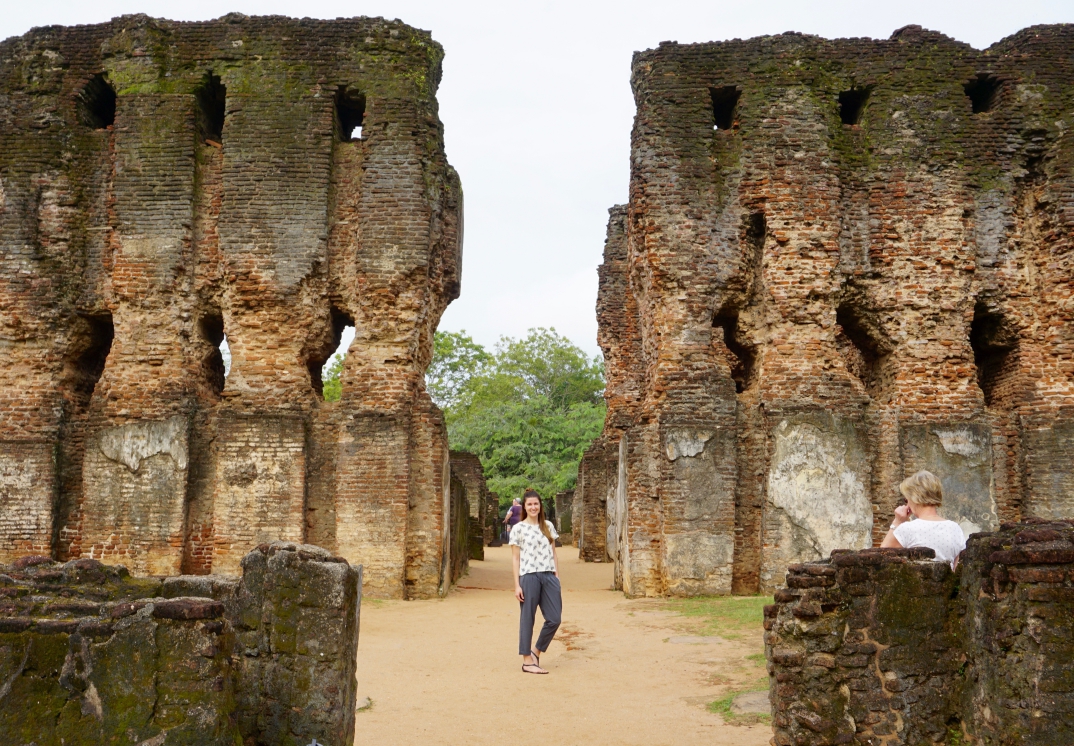
WEIJANTHA PRASADA (ROYAL PALACE)
King Parakramabahu I (1153–1186) built the Weijantha Prasada as a majestic 1,000-room, seven-story palace with all the trappings of his luxurious royal life. The structure is enclosed by massive walls over a meter thick and 30 ft (9 m) high, including a 150-foot-square central building with its pillared hall, 102 ft long and 42 ft high. Much of Plonnaruwa’s history is written in what remains of the ancient stone and
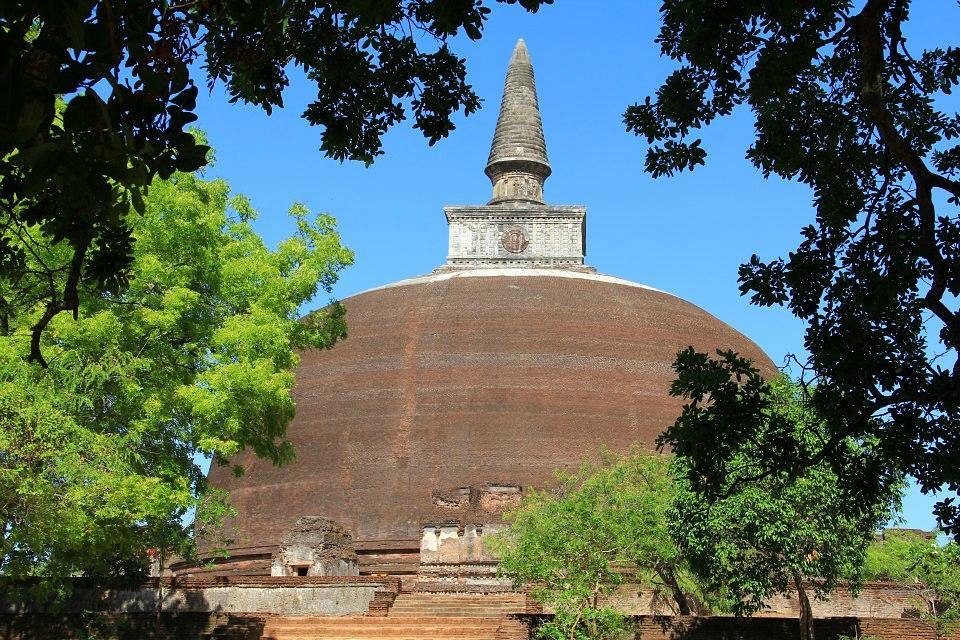
RANKOTH VEHERA
Rankoth Vehera is the largest stupa in the ruins of Polonnaruwa at 108 ft (33 m), and one of the most revered. It was built in the same style as the Ruwanweli Maha Seya in Anuradhapura, built with bricks long before being substantially renovated by King Nissanka Malla, who reigned from 1187 to 1196.
The guardstone is a distinctive characteristic of this stupa. It features an elephant instead of the more usual bull, which corresponds to the frieze of sculpted stone elephants surrounding the foundation. Within a brick boundary wall, the remains of the shrine rooms and sangawasa, where the monk lived, can still be seen on the north and south sides.
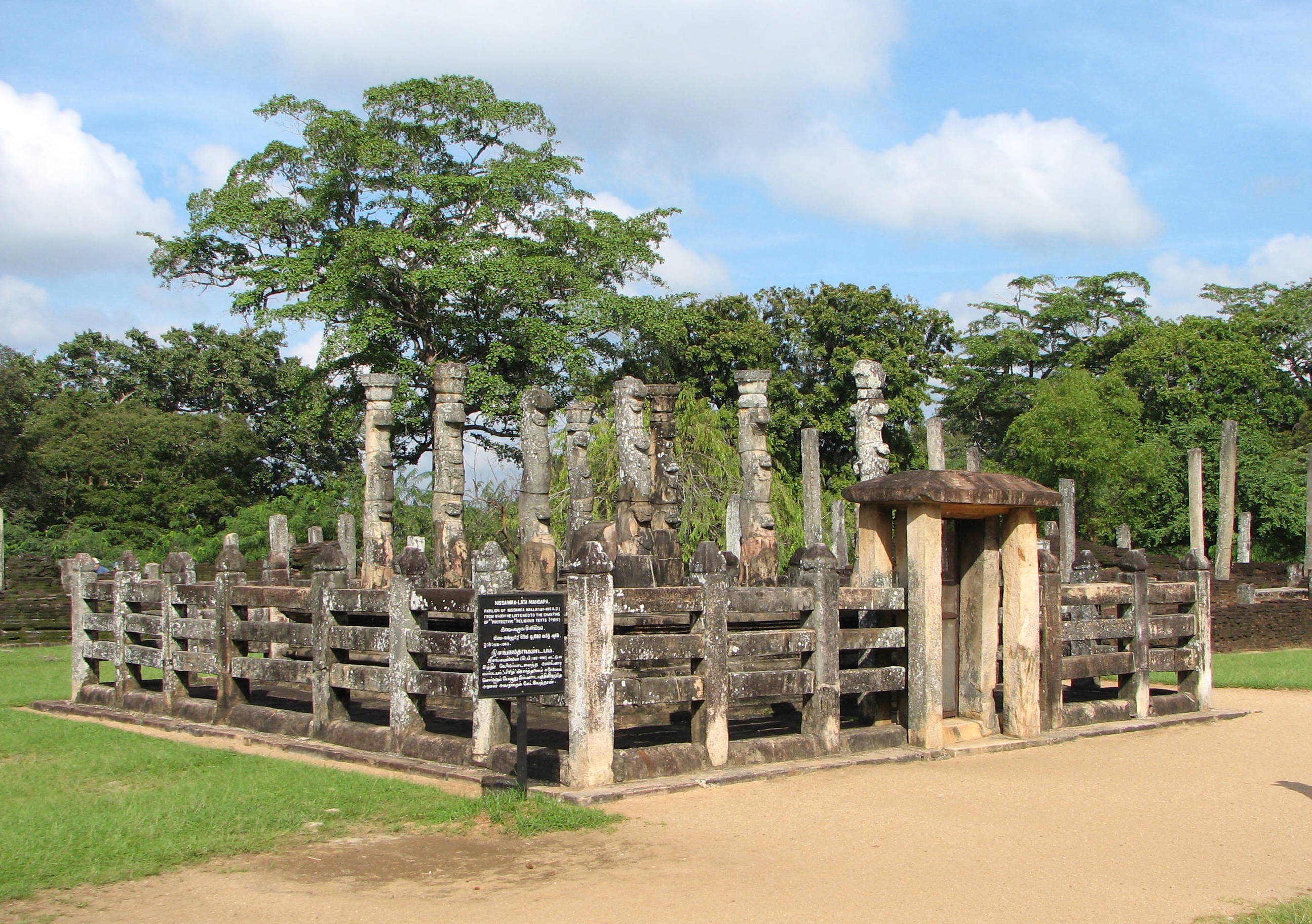
NISSANKA LATHA MANDAPAYA
A distinctive characteristic of Polonnaruwa’s ruins and their sacred architectural heritage are the stone columns Nissanka Latha Mandapaya— not straight, but curved in three places. Built by King Nissanka Malla (1187–1196), this impressive monumental structure was used for the chanting of Buddhist scriptures according to a neighboring stone inscription. The columns of the building are the best known examples of this element of ancient Sri Lankan architecture, according to leading Sri Lankan archeologist Senarath Paranavithana.
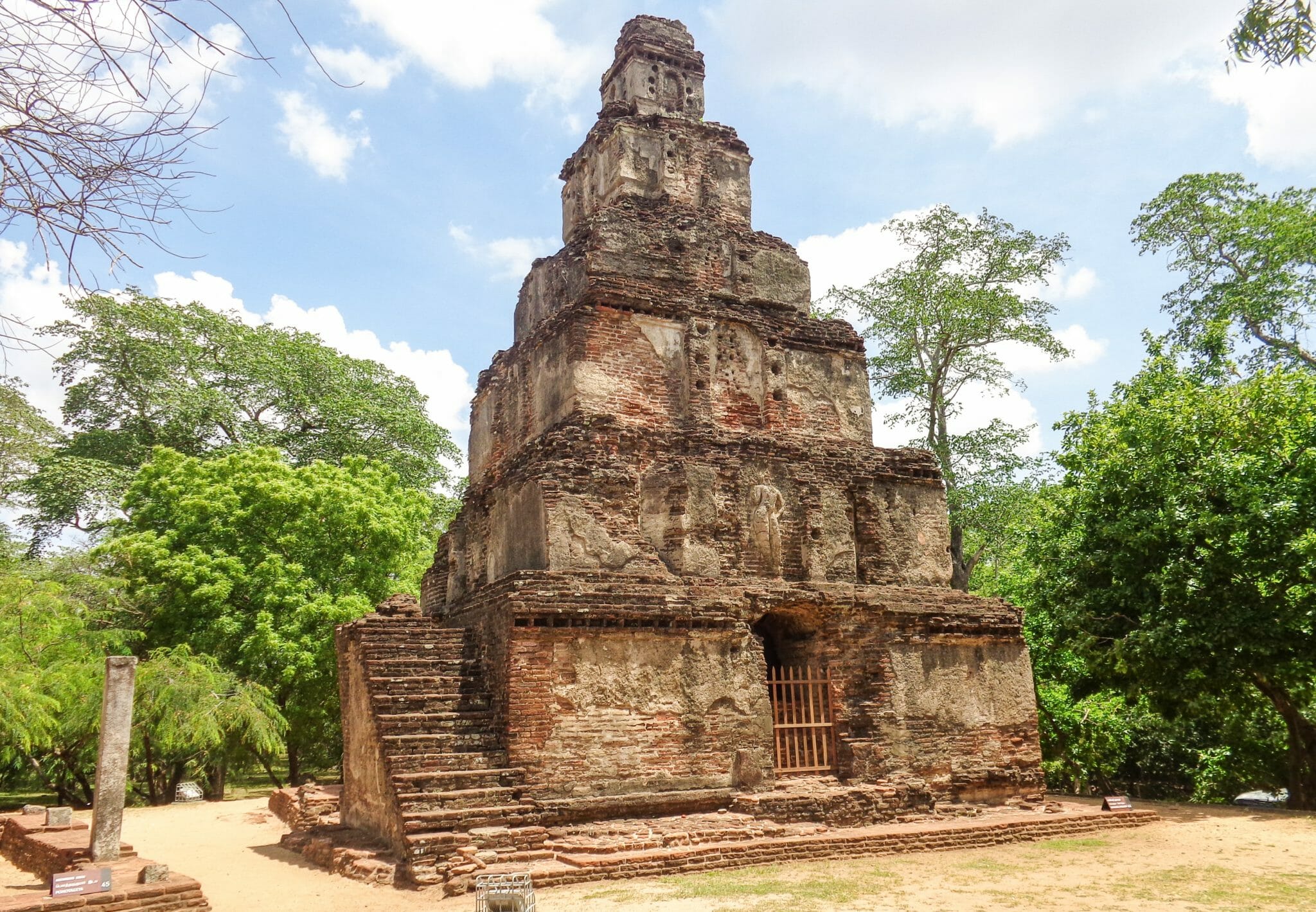
SATHMAHAL PRASADA
More mystery in Polonnaruwa’s history, this time found inside the Dalada Maluwa in the distinctive stepped-pyramid form of the Sathmahal Prasada stupa. Legend has it that this seven-story building was built for Cambodian troops who worked for the then king, reflecting the style of comparable structures found in Cambodia and Thailand.
Made of brick and over 30 ft (9 m) wide, it actually strongly resembles a stupa at Wat Kukut in Lamphun ‚ Thailand, revealing many prevalent architectural characteristics in South East Asia. No favorable proof has yet been uncovered to support the hypothesis that King Parakumbahu the Great, who ruled from 1153 to 1186, was constructing this building.
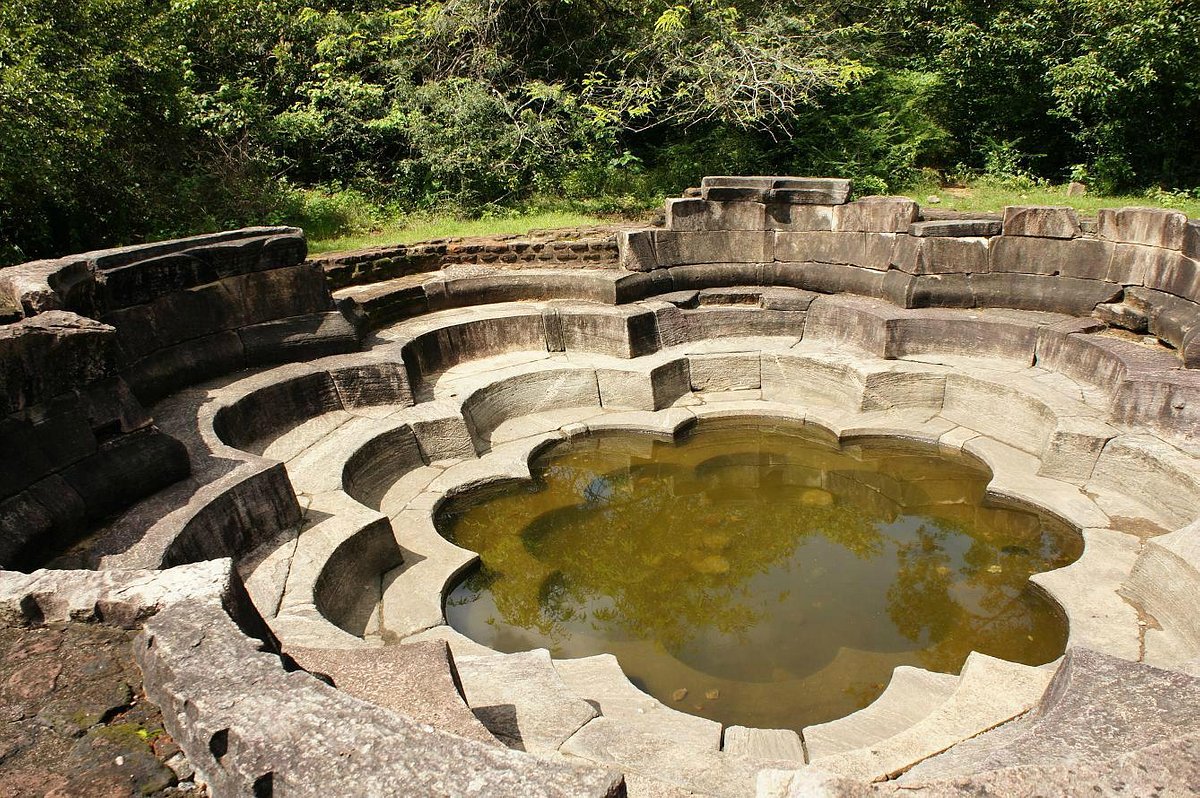
LOTUS POND
The lotus pond is a beautiful and beautifully built granite bathing pool located just outside Polonnaruwa’s primary ruins. Created in the form of an eight-petalled flower of blooming lotus, this jewel of pokuna architecture is off the beaten tourist path in a romantic and quiet garden-like environment.
In his 1990 Annual Report, the Archeological Commissioner describes it somewhat dryly as "a gigantic lotus flower of granite in full bloom 24 ft 9 in in diameter, with five concentrated laminae of eight petals gradually decreasing to 5 ft 4 in in diameter." None of which represents the charm and beauty of Polonnaruwa's mystery and history as a tiny but vital instance. This is something that, so to speak, needs to be seen in the stone to be fully appreciated.
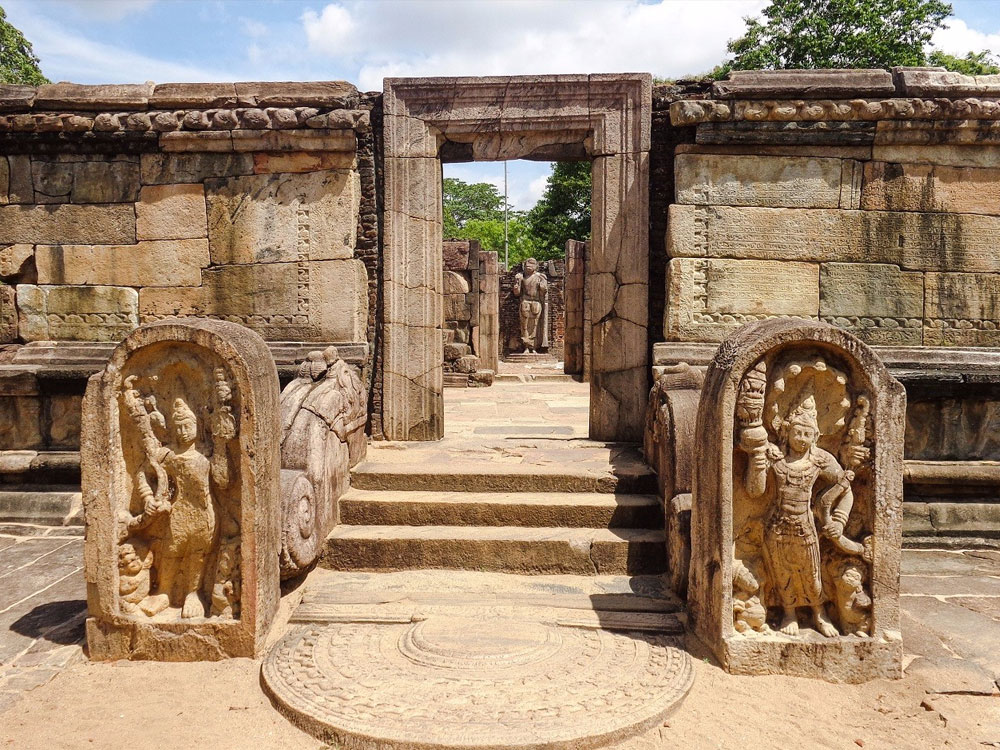
HATADAGE
Legend has it that this splendid building was finished in just 60 hours in the center of the ruins of Polonnaruwa and that it initially housed the Buddha’s Relic of the Tooth. Built of brick and wood under King Nissanka Malla’s reign (1187–1196), only part of the ground floor now remains, including an inner sanctuary containing three Buddha granite statues.
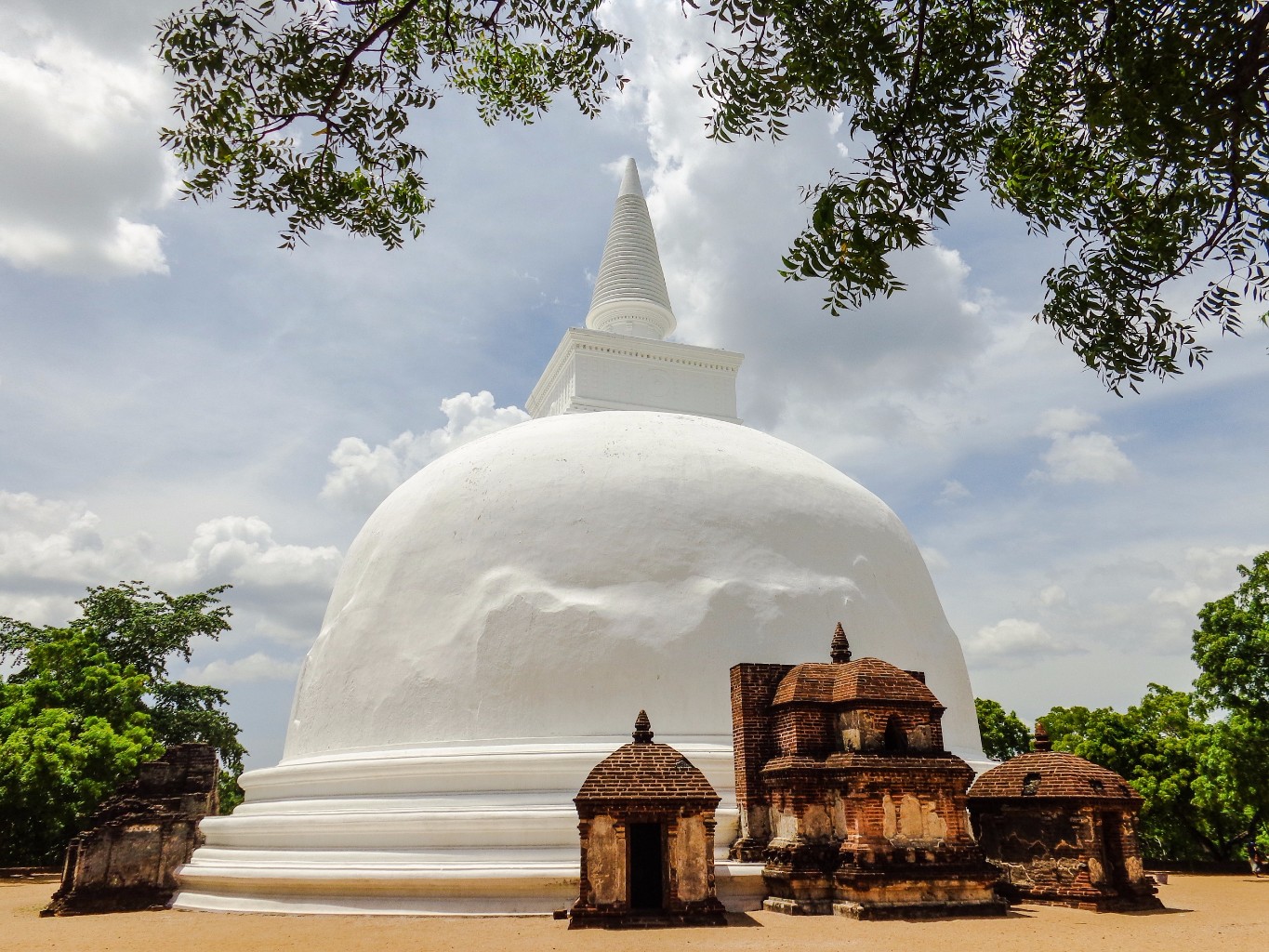
KIRI VEHERA
A queen of King Parakramabahu, who reigned from 1153 to 1186, is said to have built the 80 ft (25 m) Kiri Vehera, which lies west of the Lankathilaka Pilima Ge picture house and is the second biggest stupa at Polonnaruwa. One of the many sacred buildings that make up Polonnaruwa’s ruins, the Kiri Vehera is also the only one that has survived since it was built in its original condition, almost 900 years ago.
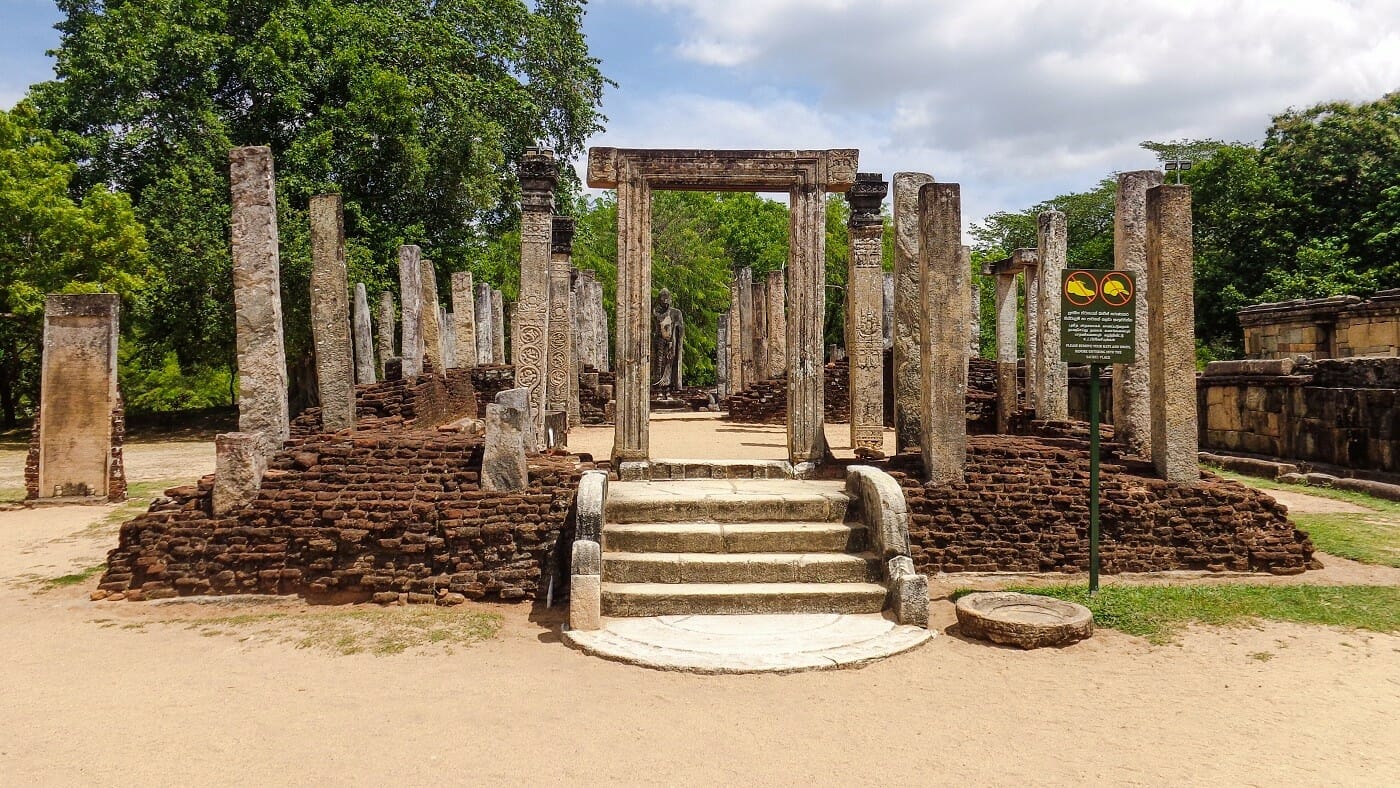
ATADAGE
Atadage Dalada Maligaya is the house constructed by King Vijayabahu I (1070-1110) of the Buddha’s tooth relic. The building is constructed on 54 pillars of stone. The tooth relic was likely produced of timber on the second floor. The second floor access is through a case of granite stairs. There are still few steps left of this staircase that led to the building’s upper chamber. At the bottom there were three Buddha statues and only one core remains today. This is also believed to be King Vijayabahu I’s only remaining building.
